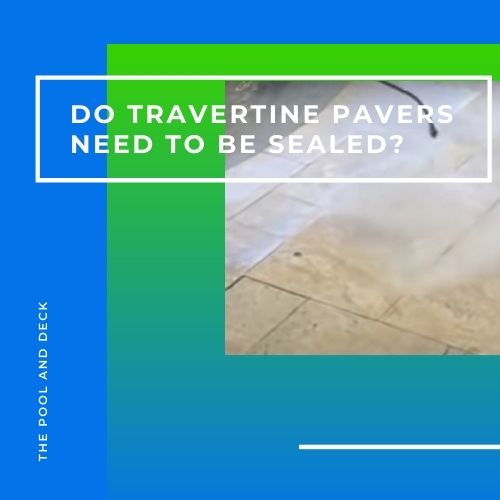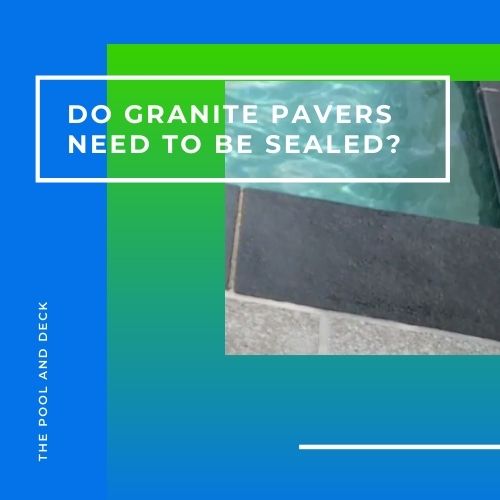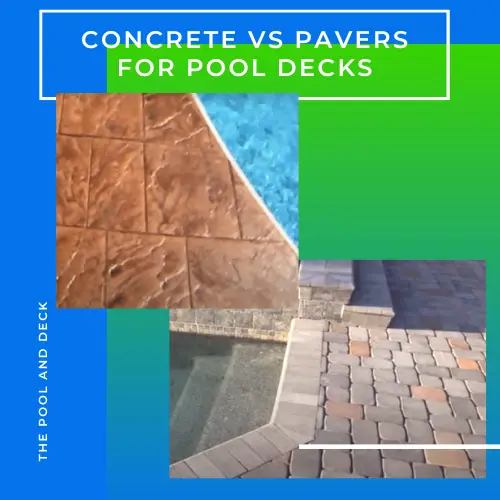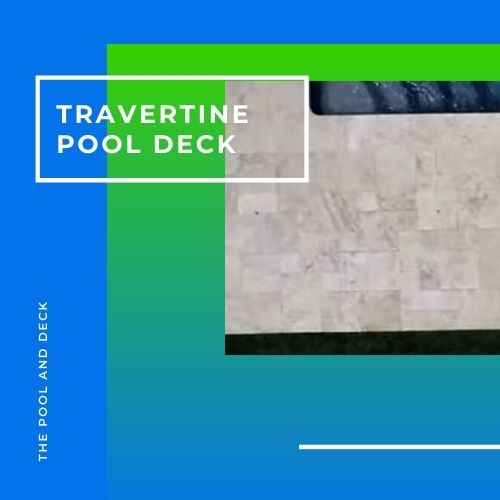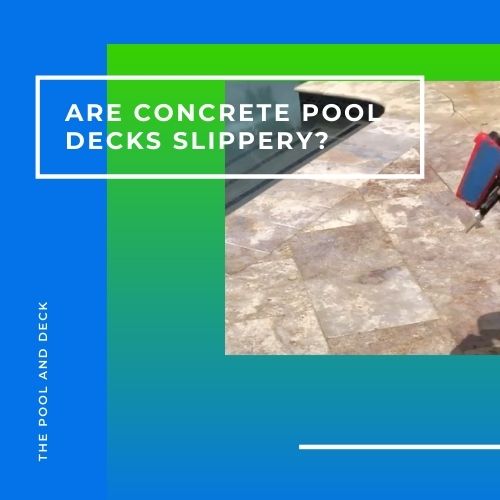Pool Deck Overlay Pavers: A Short Comprehensive Guide!
Table of Contents
What is a Pool Deck Overlay?
If your concrete pool deck is looking jaded it is certainly time to give it a face lift. You can do this by installing a pool deck overlay directly onto the old concrete deck, provided it is structurally sound. So what is a pool deck overlay?
A pool deck overlay is a thin layer of material that is installed on top of an existing pool deck to enhance its appearance and increase its life. Pool deck overlays are a cost-effective solution as they eliminate the need for a complete tear-out and rebuild.
What are Pool Deck Overlay Pavers?
Pool deck overlays can be made from a variety of materials, including concrete, pavers, stone, wood and coatings.
Pool Deck Overlay Pavers are interlocking pavers that are used to resurface existing concrete pool decks. Overlay pavers are thinner (around 1”) than regular pavers (between 2” – 3”). The existing concrete deck serves as a strong and stable base. The interlocking design makes installation really easy.
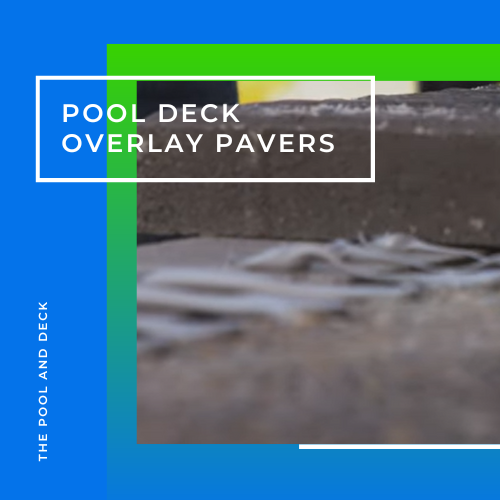
Some popular options are:
Concrete overlay pavers are cast from concrete and cured in a factory in controlled conditions to ensure uniformity, strength and durability. Special features such as shape, size, color and texture can be incorporated in the manufacturing process.
Brick overlay pavers are made from special clay and are fired at high temperatures to make them strong & durable. They come in a range of colors and can be arranged in patterns to create a unique look for the pool deck.
Stone overlay pavers are cut out from natural stone such as flagstone, slate or travertine. They offer a natural, elegant look. Though they are expensive they can completely transform your pool deck by creating a rustic and upscale appearance.
Wood overlay pavers are made of wood, such as Ipe or Treated Pine. They are a great option if you wish to create a warm, luxurious atmosphere around your pool.
Advantages of Pool Deck Overlay Pavers
After your concrete pool deck has been in service for a few years you are likely to notice several defects including:
- Cracking: Concrete always has some cracks. They are intrinsic to concrete. These are superficial but can grow over time to become unsightly or even a tripping hazard.
- Discoloration: Exposure to sunlight and pool chemicals can cause concrete to fade or discolor over time.
- Staining: Concrete pool decks are prone to staining from spills, foot traffic, moss growth, etc.
- Pitting & Spalling: Concrete deteriorates over time due to freeze-thaw cycles and exposure to moisture. Pitting & spalling results in a rough and uneven concrete deck.
- Uneven settling: Over time, the soil under a concrete pool deck can settle or shift, causing the concrete to become uneven or sink in certain areas.
There is no need to pull out and replace the concrete deck, unless it is structurally damaged. The advantage of pool deck overlay pavers is that you can completely revamp the deck at a fraction of the cost.
Specifically pool deck overlay pavers have the following benefits:
1. Increase the Lifespan of the Deck
Pool deck overlay pavers are durable, hard wearing and long-lasting. They are made from high-quality materials that can withstand foot traffic, extreme weather conditions, and exposure to pool water.
Water penetration in concrete cracks can damage the slab from within and shorten its lifespan. Overlay pavers protect the concrete deck from water getting into the cracks.
2. Make the Deck Surface Non-slip
Pool deck overlay pavers have a textured, non-slip surface. The rough texture of the pavers provides excellent traction for bare feet, even when the pool deck is wet. Overlay your slippery pool decks with a textured paver and you have less to worry when your kids are having a fun-filled pool day!
3. Are Resistant to Fading & Staining
Pool deck overlay pavers are highly resistant to fading & staining as they are treated with protective sealants. The overlay pavers are UV resistant, moisture resistant and weather resistant too.
4. Have Customizable Design Options
You can create any design or pattern on your pool deck as the overlay pavers are interlocking. Pool deck overlay pavers come in different colors, shapes and patterns to allow any level of customization.
Pool Deck Overlay Pavers: Step-by-Step Installation Process
1. Preparing the Existing Concrete Deck
To prepare an existing concrete deck for overlay pavers:
- Clean the concrete pool deck surface using a pressure washer to remove dirt, debris, and any other buildup such as algae or moss.
- Fill any cracks or holes with a concrete patching compound. Let the compound dry completely.
- Seal the concrete with a “Penetrating Sealer” to protect it from water and moisture.
2. Laying the Sand Bed
Start by creating a border by laying pavers along the deck perimeter using mortar or a construction adhesive.
Coarse sand should be added across the entire area where the pavers will be laid down. Level and compact the sand to a thickness of 1 inch.
3. Installing the Pool Deck Overlay Pavers
The pavers should be placed on top of the sand bed, leveled and adjusted as needed. Use a rubber mallet to gently tap the pavers into place. Check the leveling, once again, after laying all the pavers.
Pour polymeric sand in the gaps between the pavers, taking care not to spill any on the paver surface. Any excess sand on the pavers should be removed with a soft brush. Lightly sprinkle water over the pavers. The polymeric sand will set and lock the pavers in place.
4. Sealing the Pavers
Skip this step if the overlay pavers are pre-sealed. If not, please apply 2 coats of the appropriate “Topical Sealer”. This will protect the pavers from stains and wear & tear.
Considerations for Choosing the Right Overlay Pavers
Now that you have a fairly good idea about pool deck overlay pavers you may ask which is the right overlay paver for your pool deck? To answer this question please consider the following factors:
Climate and Weather:
The best material for pool deck overlay pavers depends a lot on the climate & weather in your area.
Hot & Dry Climates
Concrete or porcelain pavers are a good choice as they are permeable, resistant to heat and UV radiation. Permeable pavers are the best choice for hot and dry climates because they offer a combination of durability, sustainability and aesthetic appeal.
Warm & Humid Climates
Natural stone, such as granite, pavers are an excellent choice in coastal areas as they are naturally resistant to moisture and salt. Natural stone pavers are also highly durable, long-lasting and low-maintenance.
Extremely Cold Climates
Interlocking concrete or brick pavers are ideal for cold climates with lots of snow. They can withstand harsh winter weather conditions, including heavy snow and frequent freeze-thaw cycles. Being slip-resistant, they are a preferred choice where snow & ice can make decks slippery
Budget:
Your final choice will of course depend on your budget. The table below will help you get a general idea. However, these are just rough estimates. Actuals can vary depending on quality of the material, location, etc. Please check the prices from stores near you.
| Material | Cost per sq. foot |
| Concrete | $3-$10 |
| Brick | $5-$15 |
| Travertine | $15-$30 |
| Granite | $25-$50 |
| Hardwood | $15-$30 |
Thank you very much for reading the post. I do hope you found it informative and helpful.

